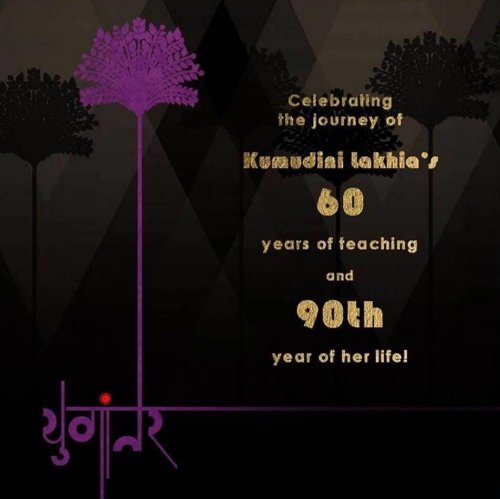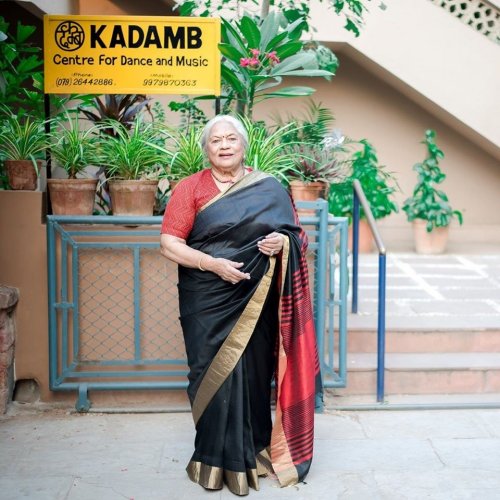
|   |

|   |
 e-mail: sunilkothari1933@gmail.com Yugantar: Kumudini Lakhia's journey of 60 years 90 and NOT out! February 26, 2020 Having known Kumudini Lakhia for more than 60 years since we met in Mumbai at Cross Maidan in 1957, it has been quite an interesting journey of her career that I have been privileged to witness. Therefore, when we few dance critics were invited to attend two day Kathak dance festival Yugantar she had planned with her disciples, all came to learn more about the trials and tribulations she had undergone when establishing her institution Kadamb to train young generation of dancers way back in 1960! She says: "There were only three dancers who joined. Then five, and then seven, and so on. I soon realized that in Ahmedabad, Kathak was not even accepted as a dance form. People had a misconception that it was considered dance of kothewalis, nachanewalis and girls from good families do not learn dance. It was a huge challenge for me to give Kathak a status that it deserved. I had returned to Ahmedabad having studied under the great Lucknow gharana master Shambhu Maharaj, Jaipur gharana master Sunderprasad and others. And I had appreciated Kathak as an excellent art form. So it became a mission for me to give Kathak the respectability that it deserved." According to Kumudini, "Kathak so far had lived a life of burden. It was first seen as a product of temples, then came an era when it was seen as a dance for Persian rulers, then came the stigma of linking Kathak with harems and then came the Bollywood era. We did not let Kathak breathe and discover its own individuality. We slotted it and wherever we thought it could go. But at Kadamb from the very beginning we gave it that individuality, to showcase the pure art form." Of course Kathak has gained its rightful place along with the other classical dance forms. And down the road because of its unique style and commitment people say that Kathak has now an Ahmedabad gharana. "Yugantar," says Kumudini, "is the coming of New Era and about Kadamb's young leaders who will take the mantle forward. 60 years is just a small step. A small contribution, in keeping this tradition pristine and alive!"  In Kathak world, there are two major figures whose contribution needs to be placed in proper perspective. One is Birju Maharaj, the doyen of Kathak, a traditional performer with a great tradition of dance for more than eight generations. His emergence as a maestro in post independence era has been most significant. The Government realized that in absence of the former rulers, Rajas and Maharajas, who supported Kathak, dancers now are no more there; it was Government's duty to support the artistes and art forms. The institutionalization of Kathak in New Delhi with efforts of Sumitra Charatram and other individuals and with establishment of Sri Ram Bharatiya Kala Kendra and Kathak Kendra as a constituent body of Sangeet Natak Akademi ushered in a new era. On the other hand individual dancers, having studied Kathak under great masters, also established their own institutions and started training the young generation. Among them in Maharashtra, Rohini Bhate and in Ahmedabad, Kumudini Lakhia were prominent. Kumudini did not belong to any traditional dance community. Trained in Kathak because her mother wanted her to learn dance, Kumudini graduated with a degree in Agriculture at Naini College in Allahabad where her father was posted. She later on studied architecture and also designing in Mumbai at Sir JJ School of Art. Having studied Kathak dance, when Ram Gopal, the internationally renowned dancer from London visiting Mumbai was looking for a dancer, he invited her to join his company and she went to London and also in major cities of Europe to perform dance. Being with Ram Gopal, she was exposed to the international dance scene, understood discipline as a part of dance training, costuming, light designing, group dance, colour sense, stage presentation and allied arts. That has stood her in good stead all her life and reflects in whatever she choreographs, designs and presents. But most important in her approach to dance is to think individually about dance. "I do not like any of my disciples to be a carbon copy of me," says Kumudini. "I want them to observe life around them, nature, movement of birds, how people talk, walk, react and imbibe from these observations creative inspirations. That should also become part of their dance." As a mentor, Kumudini has over the years instilled in her students these ideas and encouraged them to be creative. Mere mastering the technique is not supposed to be the goal. They must master technique, but then learn how to transcend that. Create something new, out of the box, innovative. It is a long process and takes long time. Kumudini nurtures her students and guides them. As happens in all cases, the relationship between a guru and his/her shishya becomes a bond. A guru teaches besides dance so many values of life.  Kumudini Lakhia "I know that from my students all are not going to be dancers. A few will become dancers. It depends upon many factors. But even when they do not become professional dancers, they will love dance and a whole generation of these students will pass on those values and love for dance to the next generation. An entire generation would start admiring dance. We will have a knowledgeable audience." I was learning Kathak in my school days at Deodhar's classes of Music and Dance at Opera House in Mumbai. But I had no advantage of someone like Kumudini as a teacher. I watched dance by Damayanti Joshi, Roshan Kumari, Sitara Devi, Gopi Krishna, Rohini Bhate. Later on, Birju Maharaj. These were the stalwarts, the pioneers, and each one had a different style. That exposure was necessary to appreciate and understand the variety and diversity of Kathak dance and the tradition. Kumudini introduced 'Contemporary Kathak'. On reflection after nearly fifty years, with her typical wry humour, Kumudini says, "When you live a life devoted to Kathak, a doctor who measures your pulse would actually hear the 'bols' of Kathak. This is the rationale behind the item I created titled Dhabkar." "Not only I created a piece with different musical compositions, but also created a different space. For the first time Indian audience saw different levels on a Kathak stage. It was first presented in New Delhi in 1973. I wanted to take attention away from one solo dancer. Thereby there was no glorification of the artiste. I also changed the costumes. Then the Art instead of the Artiste became the focus. Now when I reflect, I understand why my work was far head of its time. Today we call it unhesitatingly 'minimalism'. Many collaborators have joined me and I have also invited them. One young light designer is Gyan Dev Singh. He has been working with Kadamb for past six or more years. He watches the rehearsals, makes notes, discusses with me, studies costumes and movements, acquaints with stage space, the entries and the exits and designs lights. Light plays an important role in my productions. In Dhabkar when my two dancers stand facing each other on a raised platform, he experiments giving light from below and lit up the dancers in white light which illumined them amazingly. The background light was different and the two dancers looked so different. It took the audience's breathe away!" One item is just titled Upaj, a technical term used in Kathak, meaning improvisation. Upaj means creating new bols, patterned with the ghunghroos, to match the 'bols' of the tabla or pakhavaj. In this item, three dancers create bol patterns. Kumudini had created this work with Atul Desai's music. Rupanshi, Mitali Dhruva and Rohit Parihar presented this number. It was created in 2006. This was path breaking as three dancers were creating bol patterns to the music composed. How does she differentiate graceful feminine movements Lasya from the vigorous, energetic Tandava masculine movements? Kumudini choreographed Tarana in Kedar raga to the music composed by Madhup Mudgal. The concept was that the choice of the raga signified the male and the female energy. These energies get together to celebrate dance. It was created in 2009. When one watched it, in the beginning one saw three young girls entering the stage in graceful manner, bending their bodies like half crescent moon. Other dancers joined. Then entered five male dancers. They marched like soldiers, very masculine. The contrast was immediately noticed. Their footwork resounded with clarity and variations were inbuilt. The entire choreography was enchanting. The female dancers passed through the row of male dancers with ease and carefree mood. The performance by all of them saw several patterns to the melodious music. In final movements they formed a straight line. Their footwork gathered momentum leading to climax and the audience gave them spontaneous applause. Kumudini's disciple Aditi Mangaldas has won critical acclaim for her several choreographies and solo performances. For the first time in Ahmedabad, she presented 'Immersed' as a tribute to Kumudini, her guru and mentor.  Dr. Sunil Kothari is a dance historian, scholar, author and critic, Padma Shri awardee and fellow, Sangeet Natak Akademi. Dance Critics' Association, New York, has honoured him with Lifetime Achievement award. Post your comments Please provide your name and email id when you use the Anonymous profile in the blog to post a comment. All appropriate comments posted with name and email id in the blog will also be featured in the site. |